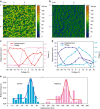Cellulose-based magnetoelectric composites
- PMID: 28659602
- PMCID: PMC5489539
- DOI: 10.1038/s41467-017-00034-4
Cellulose-based magnetoelectric composites
Abstract
Since the first magnetoelectric polymer composites were fabricated more than a decade ago, there has been a reluctance to use piezoelectric polymers other than poly(vinylidene fluoride) and its copolymers due to their well-defined piezoelectric mechanism and high piezoelectric coefficients that lead to superior magnetoelectric coefficients of >1 V cm-1 Oe-1. This is the current situation despite the potential for other piezoelectric polymers, such as natural biopolymers, to bring unique, added-value properties and functions to magnetoelectric composite devices. Here we demonstrate a cellulose-based magnetoelectric laminate composite that produces considerable magnetoelectric coefficients of ≈1.5 V cm-1 Oe-1, comprising a Fano resonance that is ubiquitous in the field of physics, such as photonics, though never experimentally observed in magnetoelectric composites. The work successfully demonstrates the concept of exploring new advances in using biopolymers in magnetoelectric composites, particularly cellulose, which is increasingly employed as a renewable, low-cost, easily processable and degradable material.Magnetoelectric materials by converting a magnetic input to a voltage output holds promise in contactless electrodes that find applications from energy harvesting to sensing. Zong et al. report a promising laminate composite that combines a piezoelectric biopolymer, cellulose, and a magnetic material.
Conflict of interest statement
The authors declare no competing financial interests.
Figures





References
-
- Landau, L. D. et al. Electrodynamics of Continuous Media. Vol. 8 (Elsevier, 1984).
Publication types
LinkOut - more resources
Full Text Sources
Other Literature Sources

